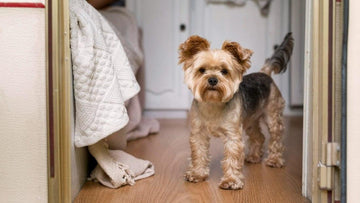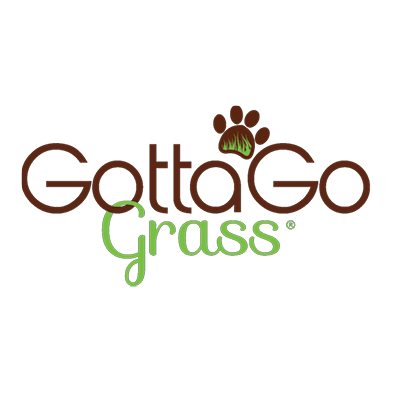
Using indoor grass pads for dogs offers many benefits, from creating a sanitary environment to reinforcing good potty habits. While it's normal to experience a few hits and misses during potty training, one of the most frustrating aspects is when a previously fully potty-trained dog suddenly can't get its aim right and misses the pad.
Whether it's a case of your dog being half-on and half-off, completely missing it, or lifting his leg and splattering pee everywhere, it can be exhausting. If you're struggling with getting your dog to pee on the pee pad, you're not alone. Good thing we have a few tips to help you troubleshoot the problem.
Help! My Dog Keeps Missing the Grass Pad
If your dog was previously using their pads without a problem and is suddenly having accidents, the first thing you should do is check for any health issues. A visit to the veterinarian can rule out medical problems like urinary tract infections, bladder issues, or other underlying health conditions. If health issues are ruled out, below are other reasons your dog might be missing the pad and how to address them.
1. Your Dog Is Confused
One likely reason your dog pees off the pad is because they haven't fully grasped the concept. This is often the case with single-use pee pads that usually end up being destroyed or played with. Dogs may think the pad is a toy, leading them to chew, scratch, and drag it around instead of using it for its intended purpose.
2. Your Dog Has Possible Behavioral Issues
Fear, stress, anxiety, or previous trauma can all contribute to unwanted behaviors, including peeing in the wrong places. Additionally, dogs may display urine-marking behavior to define their territory. This can happen with both female and male dogs, leading to accidents outside of their designated spot.
3. Your Dog Has Poor Aim
Your pup may understand that they need to go on the pad, but they may not be good at aiming yet. This can result in them missing the potty pads, particularly if they are still young and learning.
4. The Pad Is Too Small
It also doesn't help when the pad is too small. Large or male dogs, in particular, may need more space to aim properly. A small dog grass pad can result in them missing the target area.
5. The Pad Is in the Wrong Location
A wrong location can be anything from a high-traffic area, where a lot is going on that can distract your dog, to the puppy potty pad being located near their food, water, or sleeping area. Like humans, dogs prefer not to go to the bathroom near where they eat and sleep. Additionally, if the pad is difficult to reach, your pup may not be able to get to it in time, resulting in potty accidents.
6. The Pad Is Not Clean
If your dog refuses to pee on the pad, it could be because it is too soiled and needs changing. Dogs prefer to go in clean areas, and a dirty pee pad can be off-putting. While a bit of their scent on the pad can help them recognize it as their potty area, too much can make it unpleasant for them to use.

How to Resolve Your Dog Missing the Pee Pad
As soon as you observe your dog peeing off their puppy pad, step in immediately to prevent it from becoming a bad habit. Addressing the issue early can make a great difference in reinforcing good potty habits. Below are some solutions to help your dog get back on track to using the pee pad correctly.
Revisit Potty Training
If your dog suddenly stops using their pee pad or keeps missing it by a wide margin, they may benefit from a training refresh. Sometimes, dog owners fall out of their training routine too early, before the dog has fully grasped it. Going back to the potty training basics can reinforce good bathroom habits. Be as patient as you were during the initial training. Remember, most puppies aren’t consistently potty trained until around six months old, and it can take even longer for smaller breeds.
Rethink Location
Set the grass pad or relocate it where your dog is more likely to use it correctly. Avoid busy areas and opt for a quiet place where they will not get distracted while in the middle of their business. Ensure the pad is as far away as possible from where your dog eats, drinks, and sleeps.
Additionally, make sure the pad is easily accessible. This is particularly important for seniors with mobility issues and puppies or adult dogs still in housetraining. If necessary, place puppy pads in multiple locations in your home. Avoid placing the pad too close to the wall or blocked in by furniture, as they're less likely to get all the way on it before relieving themselves. Leave at least three sides of the pad open, or pull it away from the wall so they don't feel cramped.
Once you know the best place for the pad, keep it there to avoid further confusion and near misses. Give your dog clear spaces to do their business without hassle.
Use the Right Grass Pad Size
Using the right size of grass pad ensures your dog successfully hits the target, thus significantly reducing the risks of accidents and keeping your home cleaner. Larger dogs, in particular, need more space to aim accurately. If the pad is too small, your dog may accidentally soil just off the edges, leading to messes and frustration.
Gotta Go Grass® offers interlocking trays to accompany our natural dog pee pads, allowing you to create a more extensive and customizable potty area. This setup provides ample space for your dog to position themselves easily and makes it more convenient to maintain a sanitary environment.
Provide a Vertical Surface for Male Dogs
Providing a vertical element, like a cone or a fire hydrant, in the center of the grass pad can make a significant difference for male dogs who lift their leg while peeing. This recreates the natural targets they seek outdoors, like trees or real-life fire hydrants, giving them a specific place to aim for.
These accessories make the setup feel more familiar and reduce the chances of dog urine splattering on walls or furniture.
Change the Grass Pads Accordingly
Many dogs refuse to use their pee pad if it's soiled. Plus, you don't want them tracking pee paw prints from the pad onto your floor. Make sure to change the grass pad with a fresh one regularly.
Gotta Go Grass® is a long-lasting solution that lasts up to four weeks, depending on usage—whether it's a primary potty area or how many dogs use it. Check our guide on maintaining your grass pad for long-lasting use and how to refill it.

Takeaway
By checking for all possible reasons—whether it's health issues, confusion, poor aim, or the location—you can identify and resolve the problem effectively.
Gotta Go Grass® makes potty training more successful by providing a natural solution that recreates the familiar environment for outdoor potty breaks, making it easier for your dog to adapt and use the pad correctly.
Read our blog for more potty training tips and advice.



